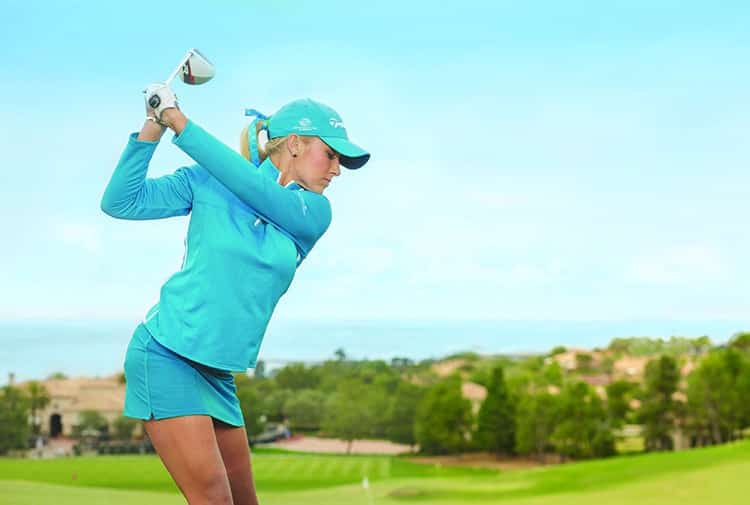Every year many of us step onto a golf course attempting to hit the ball farther, faster, and more accurately. Many people will spend thousands of dollars on equipment and course fees, even hundreds more on golf lessons, with hopes of improving their game. Unfortunately the latest technology of titanium alloy graphite composite driver cannot compensate for deficiencies in movement or poor body mechanics. Realizing that many people will continue to play over the course of their lifetime, can you imagine this pattern being repeated year after year. Unknowingly, many golfers will plateau, as they are not aware of their poor mechanics, nor do they know how to correct them.
The body’s mechanics are sequenced going through the golf swing. This sequential loading occurs from the ground up, starting at the ankle, then knee, into the hips and low back, the upper back, scapula and shoulders, and into the neck. As with many functional movements, faults in a golf swing will occur in pairs, with a compensation resulting from each fault. Let us examine the synergistic relationship between the shoulder and the scapula. The relationship of humerus movement relative to the scapula called the Scapulo-humeral rhythm, which usually occurs in a 2:1 ratio. Limited mobility of the scapula can limit the 3 dimensional movement of the shoulder complex, not allowing the scapula to clear the rotator cuff when raising the arm. Over time, repetitive impinging of the rotator cuff can result in pain, weakness, and lead to an eventual tear.
Another key component related to the movement of the shoulder/scapula complex is the amount of mobility of the upper back (thoracic spine). Although the thoracic spine is not linked to the shoulder directly, there is a connection in the kinetic chain. Consider the amount of rotation that occurs in your trunk (thoracic spine) as you wind up into the back swing. It is evident if you try and swing a club without rotating your trunk, and primarily moving the shoulders. You will generate very little, if any power, as you swing through the ball. Your shoulders and the club merely act as a whip on the follow through, as the power is generated through the hips and trunk.
Referring back to the golfer suffering from chronic Rotator Cuff symptoms, as previously mentioned; we would likely find limitations in thoracic mobility, and limited scapular movement, resulting in the constant impingement of the shoulder. For a right handed golfer suffering R shoulder pain, these symptoms will limit the amount of shoulder abduction and external rotation required to fully load the kinetic chain during the back swing. Aside from pain, this golfer will have limited power, accuracy, and be less likely to have the endurance to complete a round of golf with their buddies.
Once we have identified these limitations a proper training program must be developed to address such deficits. If you notice any professional athlete, a lot of time is spent on training activities, aside from practicing their respective sport. Functional training needs to be multi-faceted , addressing flexibility, strengthening, and endurance: more than just swinging a club. A training program needs to occur in all 3 planes of motion to allow the body to experience proper loading. You can stretch the front and back of the shoulder by holding onto a doorway and rocking your pelvis in all 3 planes of motion. To stabilize the shoulder an effective exercise is shoulder raises in all 3 planes, moving from the hip to shoulder height. To address thoracic mobility a simple but effective exercise is a lunge while raising the club overhead in all 3 planes.
Our bodies are designed to function synergistically in all 3 planes of motion. If there is a kink in one of the links, the entire kinetic chain may be affected. For those enduring golfers who refuse to allow age, or pain dictate their ability to continue playing a sport they love, focus on the movement of your body 3 dimensionally and you will achieve optimal performance.
Certain health professionals are movement specialists, who have been extensively trained in the assessment of functional human body biomechanics, and are known as Fellows of Applied Functional Science. Additional specialized training focuses specifically on the biomechanics of the golf swing. Such people are recognized as Nike Golf Performance Specialists. My name is Adam Fry, and I am among a very small group that has received the aforementioned training. My services are offered through Spooner Physical Therapy. A thorough assessment will include the breakdown of the body mechanics during the 2 main transformational zones (TZ’s) of the golf swing, which are the backswing and the follow through. Beginning posture, or address position is of great importance, as it can impact the movement of your head, shoulders and scapula as your arms bring the club back into the loaded position. We will address poor postural mechanics can limit your body’s potential to maximally load during the back swing, ultimately limiting your power on follow through.

